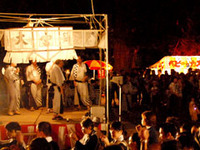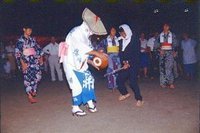

Total:35items
- Folk Performing Art (16)
- Kenbai: Sword Dance
- Kirin Shishimai: Kylin Lion Dance
- Yoshiwa Taiko Odori: Yoshiwa Drum Dance
- Omiya Odori: Omiya Dance
- Tsurusaki-Odori festival
- Omi Take-no-karakai (Tug-of-wars with bamboo)
- Nakizumo: Crying Baby Sumo
- Ryugasaki Tsukumai:Ryugasaki Acrobatic Performance
- Mikawa Manzai
- Esashi Oiwake: Esashi Folk Singing
- Ayado Yonenbutsu and Bon festival dance
- Occhi-no-Ohinagayu (rice porridge offering for the Doll's Festival in Occhi)
- Hanatori-odori Dance (Masuda area)
- Kaga-manzai
- Rice Planting festival of Tsutsukowake Shrine
- Edo sato kagura: Edo folk dance for entertaining god
- Kabuki (2)
- Noh & Kyogen (1)
- Festival (10)
- Ritual & Ceremony (2)
- Puppet Play (2)
- Folk technology (2)

 |
|
 《Feature》
《Feature》This dance is a bon festival dance performed during the bon holiday period in August every year and has been passed down in the Hiruzen area since ancient times. People dance around different shrines and temples including small wayside temples in the area every day during the holiday period. A fireworks display is held at Fukuda-jinja Shrine at night where the largest number of people comes together. There are three kinds of dances: Aoi, Shisshi, and Maneki. They dance in a circle in a slow rhythm. Cutout pictures called shirige are hung under a big lantern lit in the center of the circle and create an atmosphere of festivity.
Although the dance has been performed for a long time, the origin is not certain and there are various theories. One theory is that it began during the reign of Emperor Jimmu, the first Emperor of Japan, another theory is something related to a legend of an imaginary creature called kappa, and yet another is that actors from Osaka created the dance on their way to Daisen for a performance. However, it is said that the dance has been passed down since long ago as the meanings of some words of the song are not clear and the tempo of the dance is so slow that it looks more like an ancient court dance with elaborate moves.
When the leader sings in a high-pitched clear voice, "Natsukashiya uwahan Omiya-sama uwahanyo," drums made of paulownia wood go bang. The lantern decorated with strips of paper and cutout pictures called shirige are hung overhead, dimly illuminating the area, and in an atmosphere of festivity, three kinds of dances are performed: Aoi, Shisshi, and Maneki.
[What is Shirige?]
Omiya Dance, a bon festival dance in the Hiruzen area, is performed in a circle, centered on the oblong lantern. Shirige are cutout pictures hung under the lantern as decoration together with strips of zigzag-shaped paper. The origin of this unique name is not known, but it is said that the picture is hung under the lantern, in other words, the bottom (shiri) of the lantern, or that it's named after a story that people hung hairs (ke or ge) taken from the buttocks (shiri) of an animal to ward off specters which come to lick the oil of lanterns. It is made by putting three to five sheets of Japanese paper (Mino paper) under a rough sketch of a beautiful woman or something else, and cutting the sketch and the paper with a knife, such as a box cutter.
[A national Important Intangible Folk Cultural Property]
Provided by: Hiruzen Tourist Association
Translation: Tomoe Ukida, reviewed by Catherine Newman
| City/Town | Hiruzen area, Maniwa City, Okayama Pref. |
|---|---|
| Location | Various places in the Hiruzen area
Domeki-do (Hiruzen Kaminagata), Uezaisho-do (Hiruzen Shimonagata), Omori-do (Hiruzen Higashikayabe), Kawakami Elementary School (Summer Festival in Kawakami), Yoshimori-do (Hiruzen Kaminagata), Fukuda-jinja Shrine (Hiruzen Nakafukuda), Kofukuji Temple (Hiruzen Shimofukuda), Iimori Community House (Hiruzen Kaminagata), Nagata-jinja Shrine (Hiruzen Shimonagata) |
| Contact | Hiruzen Tourist Association
Tel 0867-66-3220 Fax 0867-66-4141 |
| Highlight/POI | A disguise dance called Tenko in the Maneki dance is the highlight of the festival. People usually dance in normal yukata (a light cotton kimono for summer), and there is no rule for costumes. However, as for Tenko, people in disguise perform a unique dance, moving their hands and bodies to the call of the leader. A person wearing a padded kimono and a braided hat like an eboshi (traditional formal headwear) with a pestle in his hand, is followed by another with a woven-rush jacket beating a Buddhist ritual gong, another with cucumbers, another wearing clothes for scooping loaches with a creel hung at the waist, and another disguised as a woman who is soon to give birth with a mortar in his hand. |
| General Participation | [Hiruzen Fireworks Display]
Date: August 15th every year Place: Fukuda-jinja Shrine (Hiruzen Nakafukuda) 414-1, Hiruzen Nakafukuda, Maniwa City, Okayama Pref. After the fireworks display, the Omiya Dance is performed inside Fukuda-jinja Shrine. General participants are welcome. The biggest performance is held at Fukuda-jinja Shrine (Omiya-sama) on August 15th every year. |
| URL | http://cms.top-page.jp/p/maniwa/3/1/10/ |



